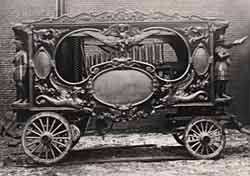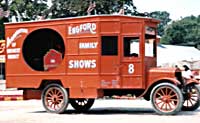| Calliopes Were Invented
in the United States
Calliopes are instruments, intended for outdoor use,
that produce musical sound using air under high pressure through stopped metal pipes or “whistles”. The word calliope is pronounced in two different ways: “kally-ope” by people in the circus and “kal-eye-o-pee” by others. The calliope is special in the world of mechanical musical instruments because of its American origin and traditional use by our circuses and riverboats.
The first calliope was a steam powered instrument played with a keyboard. It was invented by Joshua Stoddard and demonstrated by his young daughter on July 4, 1855 in Worchester, Massachusetts. The firm he started went on to produce both hand-played and automatic steam calliopes used on large riverboats. Some could be heard 12 miles away.
| Steam calliopes were not only very loud, difficult to play, and often out of tune, but they could be dangerous. However, they continued to be used for many years. |
|
This graphic description of a steam calliope tells it all:
|
|
|
 |
|
Although previously attempted by others, in 1905 Joseph Ori developed a practical low pressure air calliope. By 1912 he had established a company to hand build air calliopes. By using compressed air instead of steam, the instrument was not only safer, it was more musical. Ori’s instruments were widely used by circuses.
In 1914, Norman Baker of Muscatine, Iowa, founded a company to mass produce a similar compressed air calliope that he called a Calliaphone. These original popular Tangley Calliaphones were produced until 1931 when Baker was forced to leave Muscatine for reasons unrelated to calliopes (see sidebar).
The most popular model of Tangley Calliaphone was a 43 whistle model, CA-43, that used a Type “A” player piano roll. Because there were fewer pipes than holes in the roll, cross coupling was necessary. Although the Calliaphone could use rolls designed for the piano, the sound characteristics of the pipes benefited from special “organ” arrangements. Special “A” rolls with extended perforations that allowed the pipes to sustain their tones longer were produced by the Clark Orchestra Roll Company.
 |
The CA-43 models could also be played by hand on a keyboard and could be purchased built into a car or, for advertising purposes, built into a vehicle that resembled a product. |
Other models were made by the Tangley company as well as by other companies, most notably the National Calliope Corporation. The Tangley company designed two models, ST-43 and ST-58, which were advertised as “low volume” for indoor use. The numbers refer to the number of pipes, or “whistles”, and the ST-58 had pipes utilizing all of the music holes in the “A” rolls. However, although there are no production records, very few of the ST-58 models (perhaps two or three remain) were ever built.
The Tangley name and Calliaphone production are now owned by Dan Dohman, Miner Company, Kirksville, Missouri.
The company began with the late Dave Miner and was known as Miner Manufacturing Company, Inc. in Donnellson, Iowa. In 2002, Terry and Jan Bender asked Dave to design and build a Tangley Calliaphone ST-58 in a custom show trailer. Dan Dohman, a 22 year employee of Dave's, did much of the construction. Click on the “Our Calliope” button to see photos taken during construction.
Our special Tangley was delivered in August 2002, and is the first Miner/Tangley ST-58. The features of this new Calliaphone, especially its musical brass organ sound, represent a major advance in the design of this traditional American musical intrument.
Back to Top
|

